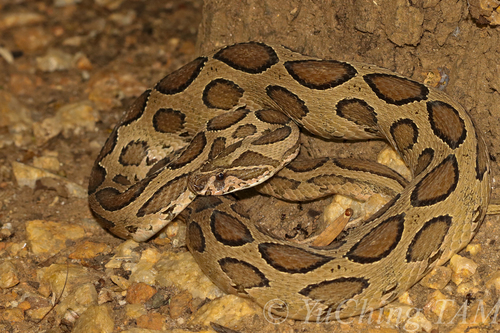
Russell's viper
Russell's viper, or Daboia russelii, boasts striking chain-like patterns and a potent venom. Found in fields and grasslands of the Indian subcontinent, this nocturnal predator regulates rodent populations, showcasing nature's delicate balance.
Length: 1.2192 - 1.8288 m
Size
Brown, Yellow, Black, Gold, Tan
Color
2-3 years
Age of Sexual Maturity
High
Aggression
Least Concern
Conservation Status
Decreasing
Population Trend
Characteristics
The Daboia russelii, commonly known as Russell's viper, inhabits grasslands, scrub jungles, and agricultural fields across the Indian subcontinent. It is a large, venomous snake known for its distinctive chain-like pattern of oval spots along its body. Russell's viper is nocturnal, often preying on rodents and small birds, playing a crucial role in controlling pest populations.
Distribution Range of the Russell's viper
Daboia russelii, commonly known as Russell's viper, is native to the Indian subcontinent. It is found across India, Sri Lanka, Bangladesh, Nepal, Pakistan, and parts of Southeast Asia including Myanmar, Thailand, and possibly Laos and Cambodia.
Russell's viper's Habitat
Environmental Conditions
Russell's viper typically inhabits open, grassy, or bushy areas, often close to human settlements where rodents, their primary prey, are abundant. They can be found in plains, agricultural fields, scrub forests, and rural gardens. The species can adapt to varied climates, from dry to humid environments, but prefers regions with moderate rainfall.
Ecological Niche
As a highly venomous snake, Russell's viper plays a crucial role in controlling the population of rodents and other small mammals. It is a terrestrial ambush predator, relying on its camouflage to remain undetected by both prey and potential threats. Its adaptability to different environments, including urban areas, highlights its ecological importance and resilience.
Copyright @ Nature Style Limited. All Rights Reserved.
 English
English